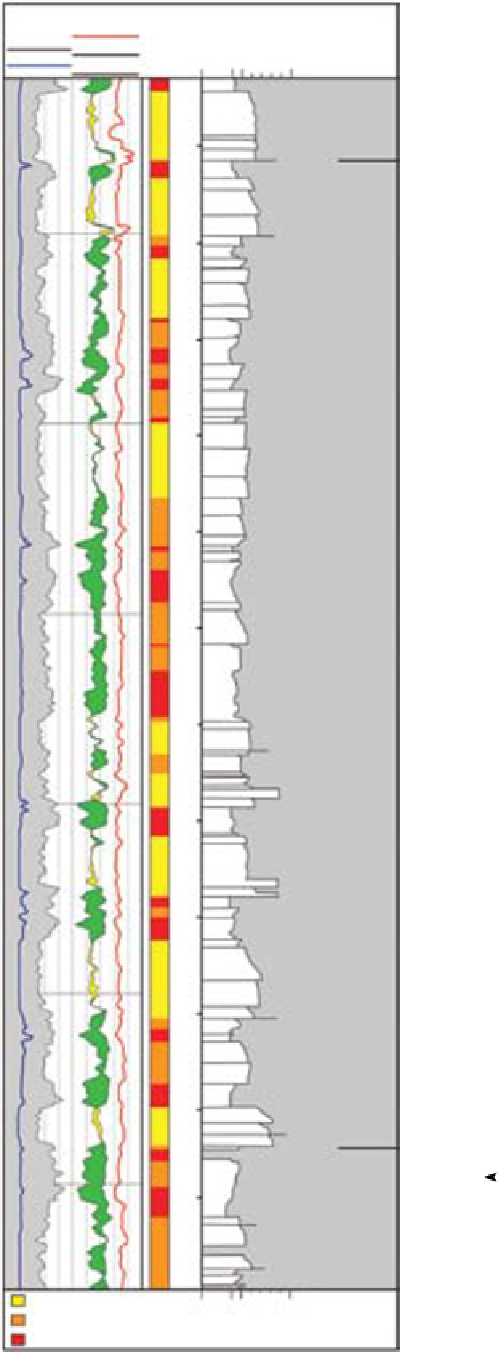Geoscience Reference
In-Depth Information
infill deposits of FSA2 are evenly distributed,
separated by floodplain mudrock units. Thin
conglomerate beds with extrabasinal pebbles are
present in L09, L08 and L07. Unit L07 is the high-
est stratigraphic level in the Lunde Formation
where extrabasinal clasts have been recorded.
The channel sandstones in the lower part of L09
and L08 are mainly structureless or plane-parallel
stratified. Rip-up mudstone clasts are common
and small calcrete clasts occur. Trough cross-
stratification with internal thin mudstone beds
becomes increasingly frequent in the channel
sandstones upwards through L09 to L06. In well
core sections, stratification shows that cross-strat-
ified beds commonly occur in several metres thick
bedsets that may be separated by thin mudstone
beds and laminae or by erosional surfaces. Upward-
fining of channel infill successions is generally
more common than in FSA1. Individual upward-
fining channel infill units, 8 m to 9 m thick (Table 5),
are separated by bioturbated floodplain mudstone.
The bioturbation is of same style as in FSA1 with
burrows up to about 1 cm in diameter and some
with chamber structure. Structureless and plane-
parallel sandstone units, up to 5 m thick, also occur,
predominantly in the upper part of L06 (Fig. 7).
The fluvial style in the lower part of FSA2 is
interpreted to be dominated by braided streams,
formed during ephemeral floods competent to
carry extrabasinal clasts far out into the alluvial
basin. The several metres thick trough cross-
stratified sandstone bedsets, separated by thin
mudstone beds or laminae, or erosional surfaces,
are interpreted as large bars composed of 3D sand
dunes, formed by lateral accretion and upward
fining in sinuous to meandering channels, probably
as point bars, as in L06. Structureless or plane-
parallel sandstone units alternating with flood-
plain mudstone are interpreted as crevasse channel
and crevasse splay deposits. The interval L07 is
interpreted to contain channel types of mixed
braided and sinuous character. Ephemeral flooding
is inferred to have decreased with increasing
sinuosity (discussed below).
34/7-1
240
DT
40
0
10
GR
120
0.45 NPHI -0.15
CALI
20
1. 95 RHOB2.95
Clay
Si
Sand
Braided stream
channel belt
L08
90
Braided stream
channel belt
2500
10
20
Braided stream
channel belt
30
40
L09
2550
60
70
Braided stream
channel belt
80
Braided stream
channel belt
90
Fig. 7.
Sedimentary log from well 34/7-1, Snorre Field,
showing characteristic stratigraphic organisation of
fluvial sandstone assemblage FSA2 in the middle part of
the Lunde Formation (MLF). Sandstone bodies are
interpreted to represent ephemeral mobile braided
streams, meandering streams and crevasse sheets and
crevasse channels. Gr = Gamma ray, CALIP = Caliper,
DT = Velocity, NPHI = Neutron porosity, RHOB = Density.
2600
L10
Channel deposits
Clay
Si
Sand
Crevasse splay/channel deposits
Floodplain deposits, red

Search WWH ::

Custom Search